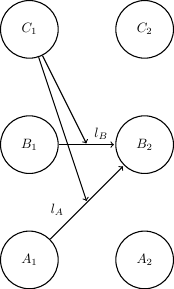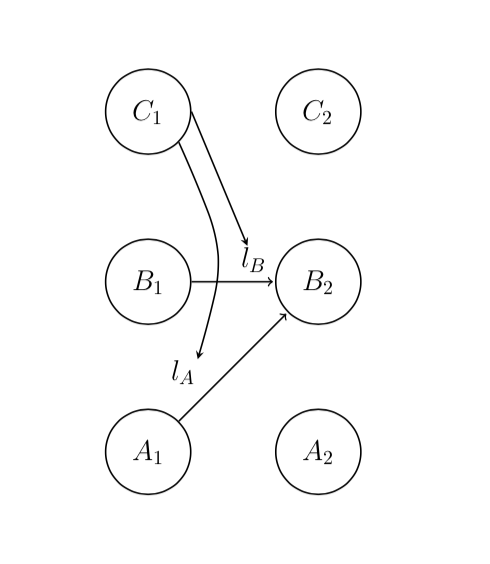I'm trying to figure out how to draw an edge between a node in tikz and the label of an edge between two other nodes. Here's an example of what I'm trying to do:
Here's my code:
\documentclass[11pt]{article}
\usepackage[margin=1in, top=1.5in]{geometry}
\usepackage{amsmath,amssymb,bbm}
\usepackage{graphicx}
\usepackage{tikz}
\usetikzlibrary{arrows, positioning}
\setlength{\parindent}{0.25in}
\newcommand{\assign}{:=}
\usepackage[hang,small,bf]{caption}
\begin{document}
\begin{figure}[!h]
\centering
\begin{tikzpicture}[shorten >=1pt,node distance=3cm,on grid,auto]
\tikzstyle{state}=[shape=circle,thick,draw,minimum size=1.5cm]
\node[state] (A1) {$A_1$};
\node[state,above of=A1] (B1) {$B_1$};
\node[state,above of=B1] (C1) {$C_1$};
\node[state,right of=A1] (A2) {$A_2$};
\node[state,above of=A2] (B2) {$B_2$};
\node[state,above of=B2] (C2) {$C_2$};
\path[->,draw,thick]
(A1) edge node {$l_A$} (B2)
(B1) edge node {$l_B$} (B2)
;
\end{tikzpicture}
\caption{Model}
\label{fig:f1}
\end{figure}
\end{document}
Can someone tell me how I can get this effect?
Thanks!




near endor on the edge likebend left. This means that the calc based midpoint solution doesn't always point to the right place. Additionally, I'm trying to show that C1 influences lA and lB, which then influence B1->B2. So I'm really looking for a way to somehow get access to the node that corresponds to the labels. Is there a way to set a variable to one of the labels? I would like something similar to(A1) edge node [near start] (lA) {$l_A$} (B2)so that I can then just do(C1) edge (lA)(that doesn't work though) – Linhliniment